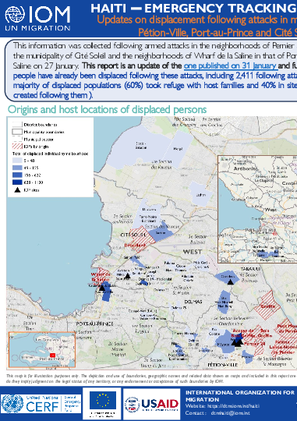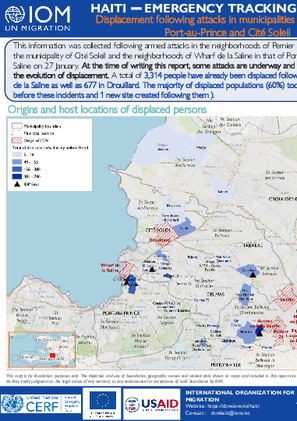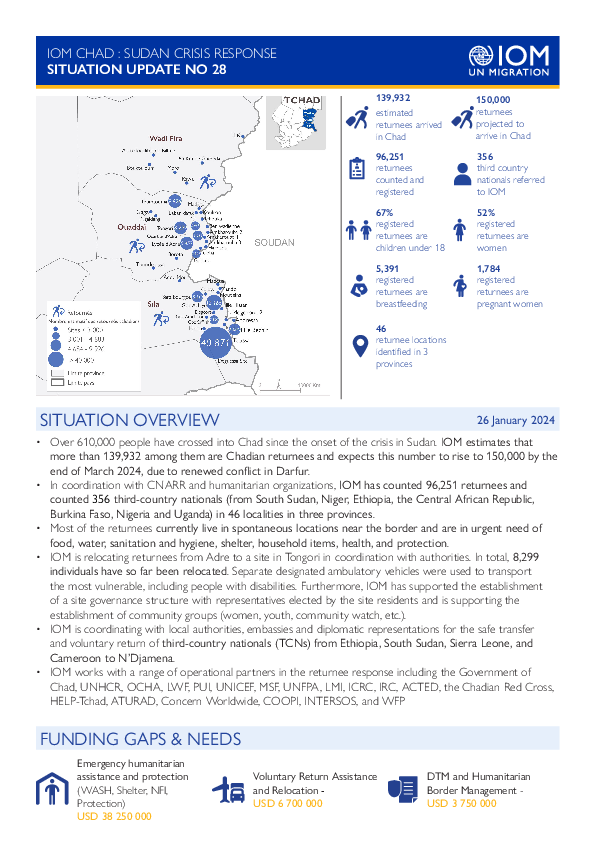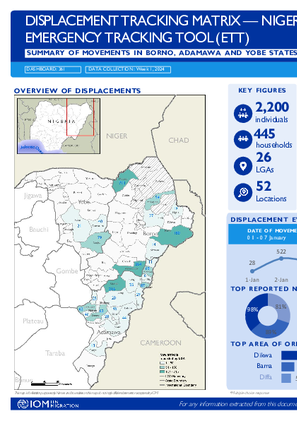-
Countries
-
Data and Analysis
-
Special Focus
-
Crisis Responses
Event Tracking

Contact
DTM Yemen, iomyemendtm@iom.int
Language
English
Location
Yemen
Period Covered
Jan 21 2024
Jan 27 2024
Activity
- Mobility Tracking
- Event Tracking
IOM Yemen DTM’s Rapid Displacement Tracking (RDT) tool collects data on estimated numbers of households forced to flee on a daily basis from their locations of origin or displacement, allowing for regular reporting of new displacements in terms of estimated numbers, geography, and needs. It also tracks returnees who returned to their location of origin.
From 1 to 27 January 2024, IOM Yemen DTM tracked 255 households (HH) (1,530 Individuals) who experienced displacement at least once.
Between 21 and 27 January 2024, IOM Yemen DTM tracked 21 households (126 individuals) displaced at least once. The majority of people moved into/within the following governorates and districts. The majority of people moved into/within the following governorates and districts:
- Al Hodeidah (13 HHs) – Hays (11 HHs), Al Khukhah (2 HHs) districts. All displacements in the governorate were internal.
- Ma’rib (7 HHs) – Ma’rib City (6 HHs), Ma’rib (1 HH) districts. Most displacements in the governorate originated from Amran and Ta’iz.
- Ad Dali (1 HH) – Ad Dali (1 HH) district. All displacements in the governorate originated from Sanaa.
The majority of people moved from the following governorates and districts:
- Al Hodeidah (13 HHs) – Hays (7 HHs), Al Hali (2 HHs), Jabal Ras (2 HHs) districts.
- Ta’iz (2 HHs) – At Taiziyah (1 HH), As Silw (1 HH) districts.
- Ibb (2 HHs) – Ar Radmah (1 HH), Al Qafr (1 HH) districts.
IOM identified 40 households displaced in the previous reporting period, which covered 14 - 20 January 2024, in the governorates of Al Hodeidah (26 HHs), Ma’rib (8 HHs), Ta’iz (6 HHs). These figures have been added to the cumulative displacement total recorded since the beginning of the year.

Contact
DTMMozambique@iom.int
Language
English
Location
Mozambique
Period Covered
Jan 22 2024
Feb 02 2024
Activity
- Mobility Tracking
- Event Tracking
Between 22 January to 02 of February 2024, a series of attacks in villages across Mecufi and Macomia, triggered the displacement 2,621. Of the total individuals displaced, 132 families with 426 individuals have taken refuge in displacement centres of Mueda (Imbuhu, Mpeme), 17 families with 76 individuals have taken refuge in displacement centres of Macomia (Nanga A and Nanga B), and 17 families with 61 individuals have taken refuge in displacement centres of Metuge (Naminaue).

Contact
dtmhaiti@iom.int
Language
English
Location
Haiti
Period Covered
Jan 27 2024
Feb 02 2024
Activity
- Mobility Tracking
- Event Tracking
This information was collected following armed attacks in the neighborhoods of Pernier and its surroundings in the municipality of Pétion Ville, in the neighborhoods of Drouillard in the municipality of Cité Soleil and the neighborhoods of Wharf de la Saline in that of Port- au-Prince. Attacks in Pernier and Drouillard began on 30 January 2024 and at Wharf de la Saline on 27 January. This report is an update of the one published on 31 January and further updates will be published according to the evolution of displacement. A total of 4,327 people have already been displaced following these attacks, including 2,411 following attacks in Pernier, 1,239 following those at Wharf de la Saline as well as 677 in Drouillard. The majority of displaced populations (60%) took refuge with host families and 40% in sites (1,731 people in 6 sites including 4 existing sites before these incidents and 2 new sites created following them ).

Contact
DTMMozambique@iom.int
Language
English
Location
Mozambique
Period Covered
Feb 01 2024
Feb 02 2024
Activity
- Mobility Tracking
- Event Tracking
Between 22 January to 01 of February 2024, a series of attacks in villages across Mecu and Macomia, triggered the displacement 2,105 across Mecufi, Metuge, Macomia, and Mueda Districts. Of the total individuals displaced, 132 families with 426 individuals have taken refuge in displacement centers of Mueda (Imbuhu, Mpeme), 16 families with 74 individuals have taken refuge in displacement centers of Macomia (Nanga A and Nanga B), and 17 families with 61 individuals have taken refuge in displacement centers of Metuge (Mieze).

Contact
dtmhaiti@iom.int
Language
English
Location
Haiti
Period Covered
Jan 27 2024
Jan 31 2024
Activity
- Mobility Tracking
- Event Tracking
This information was collected following armed attacks in the neighborhoods of Pernier and its surroundings in the municipality of Pétion Ville, in the neighborhoods of Drouillard in the municipality of Cité Soleil and the neighborhoods of Wharf de la Saline in that of Port- au-Prince. Attacks in Pernier and Drouillard began on 30 January 2024 and at Wharf de la Saline on 27 January. At the time of writing this report, some attacks are underway and the displacement of populations as a result. Updates will be published by DTM according to the evolution of displacement. A total of 3,314 people have already been displaced following these attacks, including 1,398 following attacks in Pernier, 1,239 following those at Wharf de la Saline as well as 677 in Drouillard. The majority of displaced populations (60%) took refuge with host families and 40% in sites (1,331 people in 4 sites including 3 existing sites before these incidents and 1 new site created following them ).

Contact
DTM Burundi, DTMBurundi@iom.int
Language
French
Location
Burundi
Period Covered
Jan 21 2024
Jan 27 2024
Activity
- Mobility Tracking
- Event Tracking
La DTM a identifié 2 785 personnes affectées, dont 141 personnes déplacées par les pluies torrentielles et la grêle dans les provinces de Cankuzo, Kayanza, Gitega, Rutana et Makamba.

Contact
DTM Chad, dtmtchad@iom.int
Language
English
Location
Chad
Period Covered
Jan 26 2024
Jan 26 2024
Activity
- Mobility Tracking
- Event Tracking
Over 610,000 people have crossed into Chad since the onset of the crisis in Sudan. IOM estimates that more than 139,932 among them are Chadian returnees and expects this number to rise to 150,000 by the end of March 2024, due to renewed conflict in Darfur.
• In coordination with CNARR and humanitarian organizations, IOM has counted 96,251 returnees and counted 356 third-country nationals (from South Sudan, Niger, Ethiopia, the Central African Republic, Burkina Faso, Nigeria and Uganda) in 46 localities in three provinces.
• Most of the returnees currently live in spontaneous locations near the border and are in urgent need of food, water, sanitation and hygiene, shelter, household items, health, and protection.
• IOM is relocating returnees from Adre to a site in Tongori in coordination with authorities. In total, 8,299 individuals have so far been relocated. Separate designated ambulatory vehicles were used to transport the most vulnerable, including people with disabilities. Furthermore, IOM has supported the establishment of a site governance structure with representatives elected by the site residents and is supporting the establishment of community groups (women, youth, community watch, etc.).
• IOM is coordinating with local authorities, embassies and diplomatic representations for the safe transfer and voluntary return of third-country nationals (TCNs) from Ethiopia, South Sudan, Sierra Leone, and Cameroon to N’Djamena.
• IOM works with a range of operational partners in the returnee response including the Government of Chad, UNHCR, OCHA, LWF, PUI, UNICEF, MSF, UNFPA, LMI, ICRC, IRC, ACTED, the Chadian Red Cross, HELP-Tchad, ATURAD, Concern Worldwide, COOPI, INTERSOS, and WFP

Contact
DTM Nigeria, iomnigeriadtm@iom.int
Language
English
Location
Nigeria
Period Covered
Jan 08 2024
Jan 14 2024
Activity
- Mobility Tracking
- Event Tracking
Between 08 and 14 January 2024, a total of 6,114 new arrivals were recorded at locations in Adamawa and Borno states. The new arrivals were recorded at locations in Askira/Uba, Bama, Biu, Dikwa, Gwoza, Hawul, Kaga, Kwaya/Kusar, Mobbar, Monguno and Ngala Local Government Areas (LGAs) of the most conflict-affected Borno State and in Fufore, Girei, Gombi, Guyuk, Hong, Madagali, Maiha, Michika, Mubi North, Mubi South, Numan, Song, Yola North and Yola South LGAs of Adamawa State.
ETT assessments identified the following movement triggers: Attacks (4,286 individuals or 70%), poor living conditions (997 individuals or 16%), family re-unification (215 individuals or 4%), military operations (195 individuals or 3%), fear of attack (178 individuals or 3%), access to humanitarian support (125 individuals or 2%), improved security (74 individuals or 1%) and seasonal farming (44 individuals or 1%).

Contact
DTM Nigeria, iomnigeriadtm@iom.int
Language
English
Location
Nigeria
Period Covered
Jan 01 2024
Jan 07 2024
Activity
- Mobility Tracking
- Event Tracking
On 1 January 2024, a non-state armed group (NSAG) reportedly attacked Gatawarwa Town in the Gatamarwa ward of Chibok LGA in Borno State. The attack affected 114 individuals. As a result of the attack, 12 fatalities and 16 injuries were reported.
On 7 January 2024, NSAG reportedly attacked Kwapre in Garaha ward of Hong LGA of Adamawa State. The attack affected 1,952 individuals and displaced 530 individuals to the communities of Thabu and Cross River in Thilbang ward and 1,322 individuals to the communities of Kwabaktina, Kukurpu and Waja in Hong ward of Hong LGA. As a result of the attack, three fatalities and 30 injuries were recorded.

Contact
DTM Nigeria, iomnigeriadtm@iom.int
Language
English
Location
Nigeria
Period Covered
Jan 01 2024
Jan 07 2024
Activity
- Mobility Tracking
- Event Tracking
Between 01 and 07 January 2024, a total of 2,200 new arrivals were recorded at locations in Adamawa, Borno and Yobe states. The new arrivals were recorded at locations in Askira/Uba, Bama, Gwoza, Mafa, Mobbar, Monguno and Ngala Local Government Areas (LGAs) of the most conflict-affected Borno State, in Demsa, Fufore, Ganye, Girei, Gombi, Guyuk, Hong, Madagali, Maiha, Michika, Mubi North, Mubi South, Song, and Yola South LGAs of Adamawa State and in Damaturu, Fune and Gujba LGAs of Yobe State.
ETT assessments identified the following movement triggers: poor living conditions (1,100 individuals or 50%), attacks (273 individuals or 12%), family re-unification (249 individuals or 11%), military operation (180 individuals or 8%), fear of attack (151 individuals or 7%), seasonal farming (87 individuals or 4%), improved security (86 individuals or 4%) and access to humanitarian support (74 individuals or 3%).
Pagination
- Previous page
- Page 47
- Next page
